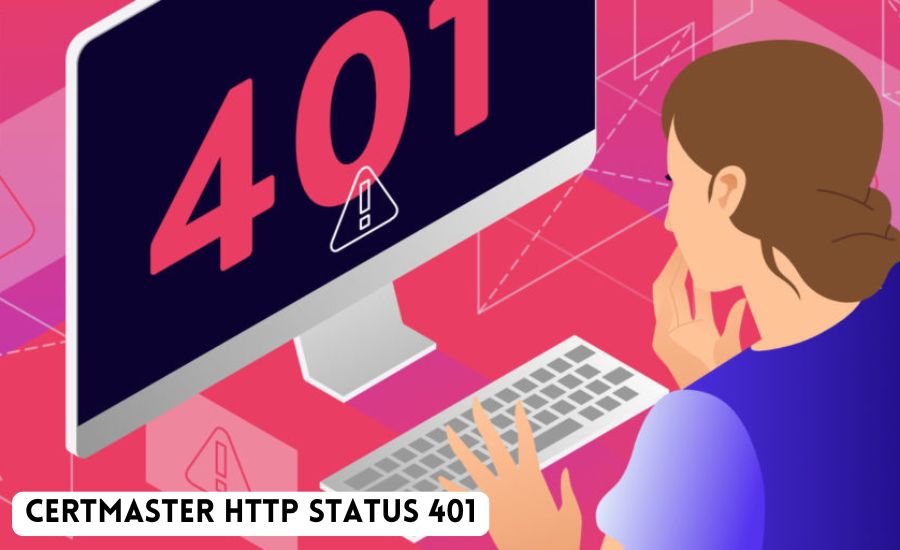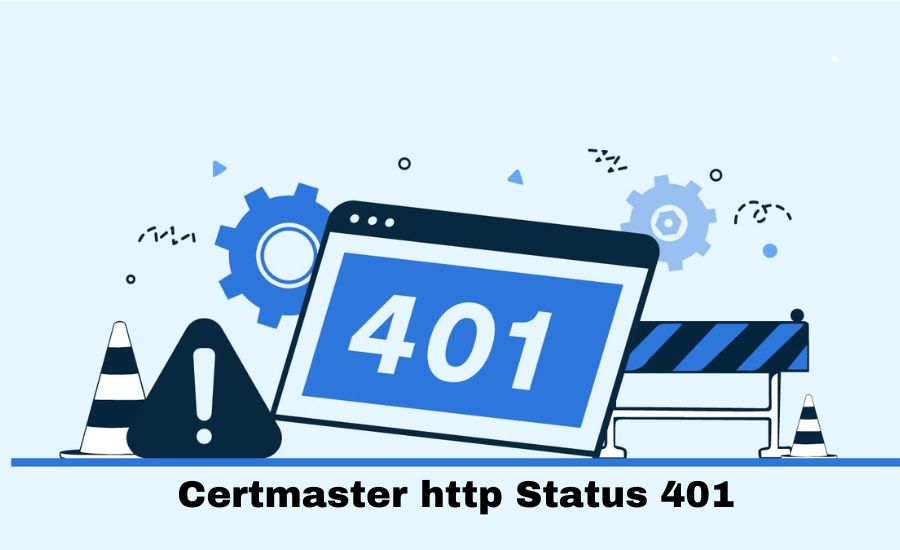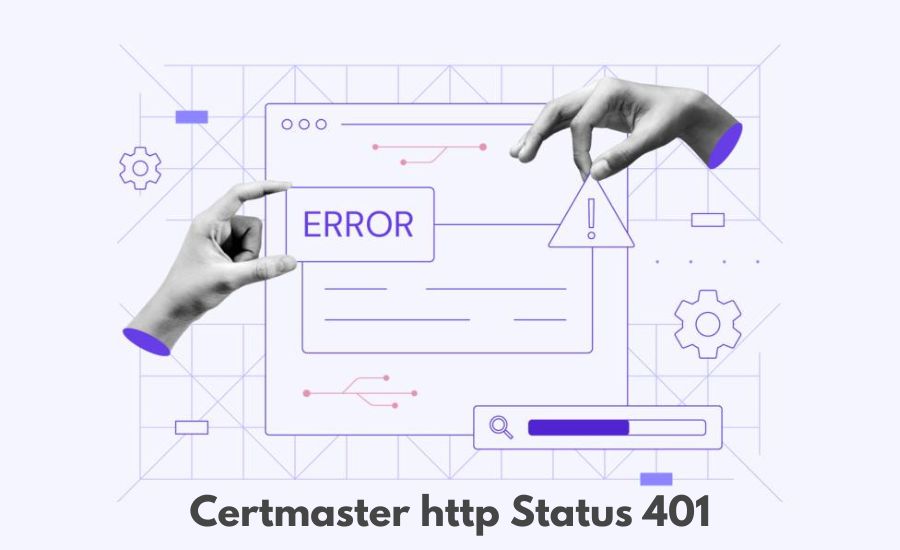The CertMaster HTTP Status 401 error can be very frustrating for users who want to access their study materials. If you’ve come across the CertMaster HTTP Status 401, it means that there is a problem with your login or permissions. But don’t worry! This error is usually easy to fix once you know what’s causing it.
In this blog post, we will explain what the CertMaster HTTP Status 401 error is, why it happens, and some simple steps to fix it. Whether you are a new user or an experienced learner using CertMaster, understanding this error will help you solve it quickly and get back to your studies without any issues!
What is CertMaster HTTP Status 401?
CertMaster HTTP Status 401 is an error message that tells you that you are not allowed to access a page or resource. This happens when the server blocks your request because it thinks you are not logged in or your login is not correct. This type of error is usually seen when there are issues with usernames, passwords, or session timeouts.
If you are using CertMaster and see this error, it usually means you need to check your login details or re-login. The CertMaster HTTP Status 401 error may also show up if your account permissions do not allow you to view certain content. Knowing what this error means is the first step to fixing it and getting back to learning smoothly.
The HTTP Status 401 error is common in online learning platforms like CertMaster. It is part of the 4xx group of HTTP status codes, which are related to mistakes made by the client (the user). Understanding this will help you solve the problem faster and continue using CertMaster without interruptions.
Why Does CertMaster Show HTTP Status 401?
CertMaster may show the HTTP Status 401 error for a few different reasons. One reason is if you enter the wrong login details, like an incorrect username or password. When the system sees this, it will not allow you to move forward. Double-check your login information to make sure you are entering everything correctly.
Another reason for the CertMaster HTTP Status 401 error is expired sessions. This happens when you are logged in but inactive for a long time. The system automatically logs you out for security reasons. To fix this, simply log back in and refresh the page. This should solve the issue.
Lastly, permissions can also be a cause. If your account does not have access to a certain resource, you may see this error. To fix this, check your account permissions or contact the CertMaster support team. Understanding why the error happens is key to finding the right solution quickly.
Common Causes of CertMaster HTTP Status 401
There are a few common causes of the CertMaster HTTP Status 401 error. Knowing these common causes will help you tackle the issue effectively.
Incorrect Login Information: Entering the wrong username or password is the most common reason for getting a 401 error. Always double-check your details before trying to log in again.
Expired Session: If your session has expired due to inactivity, you may receive a 401 error. Simply re-login to refresh your session.
Browser Cache and Cookies Issues: Old or corrupted cache and cookies can interfere with authentication, leading to a 401 error. Clearing them often resolves the problem.
Account Permissions: Trying to access content beyond your account’s permission level can cause a 401 error. Make sure you have the right permissions for the resources you want to access.
Firewall or Security Software: Occasionally, firewalls or antivirus software may mistakenly block your connection, triggering a 401 error. Temporarily disable them to see if it fixes the issue.
CertMaster HTTP Status 401: Missing Login Information

One reason you may see the CertMaster HTTP Status 401 error is due to missing login information. This happens when you try to access CertMaster without entering your username and password correctly. If the server does not get the right information, it cannot confirm your identity, resulting in this error.
To fix this, go back and check your login details. Make sure you have entered your username and password exactly as they should be. Sometimes, even a small typo can cause big problems. After verifying, try logging in again and see if the issue is resolved. This step often fixes the problem.
If you are still having trouble, consider resetting your password. CertMaster has options to reset or recover your login credentials. Just follow the instructions provided on the platform. This will ensure you have the right information, making it easier to access your account without the HTTP Status 401 error.
Quick Fixes for CertMaster HTTP Status 401
There are a few quick fixes to try when dealing with the CertMaster HTTP Status 401 error. These quick fixes can help resolve the CertMaster HTTP Status 401 error, so you can get back to using the platform without delay.
Verify Login Credentials: Double-check your username and password for accuracy. Ensure Caps Lock is off and that you’re using the correct keyboard layout.
Clear Cache and Cookies: Go to your browser settings and clear your cache and cookies. This can help remove any outdated session data.
Re-login: If you were inactive for a while, your session might have expired. Simply log back into CertMaster to regain access.
Check Account Permissions: Make sure your account has the necessary permissions for the content you’re trying to access. If unsure, consult with an administrator.
Disable Firewall or Security Software: Temporarily turn off any firewalls or antivirus programs to see if they are blocking your access.
Try a Different Browser: Sometimes, switching to a different browser can help bypass the issue.
Contact Support: If the problem persists, reach out to CertMaster support for further assistance.
CertMaster 401: Wrong Password?
One of the most common reasons for seeing the CertMaster HTTP Status 401 error is entering the wrong password. Even a small typo in your password can cause this issue. Make sure to check if the caps lock is turned off and your keyboard layout is correct. Sometimes, switching devices can also result in different keyboard settings, leading to errors when typing the password.
If you are sure that your password is correct and you still see the CertMaster HTTP Status 401 error, try resetting your password. Most platforms, including CertMaster, have a “Forgot Password” option. Click on it, follow the steps, and set a new password. This can solve the problem quickly.
If the issue persists, double-check your username as well. In some cases, the error may occur because the username and password combination is incorrect. Taking these steps will help you address the CertMaster HTTP Status 401 error caused by wrong password entries.
Session Expired? How to Fix It
Another cause of the CertMaster HTTP Status 401 error is a session timeout. This happens when you are inactive for a long period while logged in. CertMaster, like many other platforms, will automatically log you out for security reasons. When you try to access a page after your session has expired, you might see the 401 error.
To fix this, simply log back into CertMaster. Go to the login page and enter your details again. Refresh the page, and you should be able to continue without any issues. If you frequently experience session timeouts, consider saving your work often and re-logging in after long breaks to avoid this error.
If logging in does not solve the issue, clear your browser’s cookies and cache before trying again. Sometimes, expired session data remains in your browser and causes confusion. Following these steps can resolve session-related CertMaster HTTP Status 401 errors effectively.
Browser Issues Causing CertMaster 401

Your browser can also be the reason for the CertMaster HTTP Status 401 error. Sometimes, outdated cache or cookies can interfere with the login process. This happens when old data stored in the browser does not match the current session details, making it appear as though you are not authorized.
To solve this, start by clearing your browser’s cache and cookies. Go to the browser settings, look for the “Clear Browsing Data” option, and select the cache and cookies to delete. After clearing, restart the browser and try logging in to CertMaster again. This often solves the issue instantly.
If clearing the cache and cookies does not work, try switching to a different browser. For example, if you are using Chrome, try logging in using Firefox or Safari. This can help determine if the issue is specific to one browser. Solving browser-related CertMaster HTTP Status 401 errors can make accessing the platform easier and smoother.
Account Permissions & 401 Errors
The CertMaster HTTP Status 401 error can also happen due to account permissions. If you are trying to access a resource that requires a higher permission level than your account has, the system will block you. This is a security measure to prevent unauthorized access to sensitive content.
If you think this is the problem, check your account settings or contact CertMaster’s support team. They can help verify your access level and let you know if you need an upgrade. Sometimes, instructors or administrators can also change your permissions to grant you access.
For students or users with basic accounts, upgrading your account might be necessary to view certain content. Understanding your account permissions can help you avoid CertMaster HTTP Status 401 errors and ensure smooth access to all the features and content you need.
Clearing Cache to Fix CertMaster 401
Sometimes, clearing your browser cache is a simple fix for the CertMaster HTTP Status 401 error. Old cache data can cause confusion during the login process, leading to authorization issues. The first step is to go to your browser’s settings menu and find the “Clear Browsing Data” option. Select “Cache” and “Cookies” from the list.
After clearing, restart your browser and try accessing CertMaster again. This removes any outdated information and allows the server to see your fresh login request, which can solve the problem. If you are using multiple browsers, consider clearing the cache on each one.
Another tip is to try using a private or incognito window. This mode does not store cache or cookies, so it provides a clean login experience. This method can be very effective for solving cache-related CertMaster HTTP Status 401 errors quickly and easily.
You Should Know: YouTube Shorts
Step-by-Step CertMaster 401 Solution
To fix the CertMaster HTTP Status 401 error step-by-step, start by verifying your login credentials. Following these steps in order will help resolve the CertMaster HTTP Status 401 error efficiently.
- Check Login Credentials
Ensure that your username and password are correct. Double-check for typos and correct case usage. - Reset Password
If you can’t remember your password, use the “Forgot Password” link to reset it. - Clear Browser Cache and Cookies
Go to your browser settings and clear the cache and cookies to remove outdated information. - Re-login After Session Timeout
If you’ve been inactive for a while, log out and then log back in to refresh your session. - Review Account Permissions
Check if your account has the right permissions to access the content. Contact your administrator if necessary. - Check Firewall and Security Settings
Disable your firewall or antivirus temporarily to see if it’s blocking your access. - Try a Different Browser
If the issue persists, switch to a different web browser to rule out browser-specific problems.
Prevent CertMaster 401 in Future

To avoid the CertMaster HTTP Status 401 error in the future, always double-check your login details. Make sure your username and password are saved securely and entered correctly each time. Consider using a password manager to avoid typing errors, which are a common cause of this issue.
Another good practice is to clear your browser’s cache and cookies regularly. Doing this every few weeks can prevent outdated data from causing login problems. Using a private or incognito window can also help reduce the chance of seeing the CertMaster HTTP Status 401 error.
Finally, keep track of your session activity. If you are inactive for long periods, log out and log back in when you return. This prevents session timeouts that can cause authorization errors. By following these tips, you can prevent the CertMaster HTTP Status 401 error and enjoy a smoother experience.
When to Contact CertMaster Support
Sometimes, the CertMaster HTTP Status 401 error is more complex and cannot be solved through basic troubleshooting. In such cases, it’s best to contact CertMaster’s support team. They have the tools to look deeper into the issue and find out if it’s related to your account or a larger system problem.
When reaching out, provide as much information as possible. Include details like your account type, the error message you see, and what steps you have already tried. This will help the support team find a solution faster. They may also suggest changes to your account settings if needed.
Don’t hesitate to ask for help if the CertMaster HTTP Status 401 error persists. The support team is there to assist you and ensure you have a smooth experience. Contacting them can save time and prevent frustration, especially if the error disrupts your learning.
CertMaster 401: A Beginner’s Guide
For beginners, the CertMaster HTTP Status 401 error can be confusing. This error means that you are not authorized to access a page, usually due to login issues. Understanding why it happens and how to fix it can make the learning experience much easier.
Start by checking your login details. Make sure your username and password are entered correctly. If this doesn’t solve the problem, try clearing your browser’s cache and cookies. This step removes any old data that might interfere with your session.
If you still see the error, consider resetting your password or contacting CertMaster support. By following these steps, even beginners can solve the CertMaster HTTP Status 401 error quickly and effectively.
Conclusion
The CertMaster HTTP Status 401 error can be frustrating, but it’s usually easy to fix. Most of the time, it happens because of wrong passwords, expired sessions, or simple browser issues. Always start by checking your login details, clearing your cache, and making sure your session hasn’t timed out. These simple steps can save a lot of time and help you get back on track quickly.
If these solutions don’t work, it might be a problem with your account permissions or something bigger. In this case, contacting CertMaster support is the best idea. They can help check what’s going wrong and guide you step-by-step. By following these tips, you can avoid the CertMaster HTTP Status 401 error in the future and enjoy a smoother experience using the platform.
Must Read: Chelley Henry Google Scholar
FAQs
Q: What is CertMaster HTTP Status 401?
A: CertMaster HTTP Status 401 is an error code that indicates you are not authorized to access certain content. It often means that your login credentials are missing or incorrect.
Q: Why am I getting the CertMaster HTTP Status 401 error?
A: This error typically appears due to incorrect login details, expired sessions, or restricted account permissions. Double-check your username and password or try logging in again.
Q: How can I fix the CertMaster HTTP Status 401 error?
A: To fix it, check your login credentials, clear your browser cache and cookies, or try logging in again. If the problem continues, review your account permissions.
Q: Does clearing cache help resolve CertMaster 401?
A: Yes, clearing your browser’s cache and cookies can resolve outdated session issues that may cause the 401 error.
Q: What should I do if I forgot my CertMaster password?
A: If you forgot your password, click on the “Forgot Password” link on the login page to reset it. Follow the instructions to set up a new password.
Q: Can a firewall cause CertMaster 401 errors?
A: Yes, sometimes firewalls or antivirus software can block login attempts, causing the 401 error. Try disabling them temporarily to see if it resolves the issue.
Q: When should I contact CertMaster support for the 401 error?
A: Contact support if none of the basic troubleshooting steps work or if you believe your account permissions need adjustment. They can provide more detailed help.
